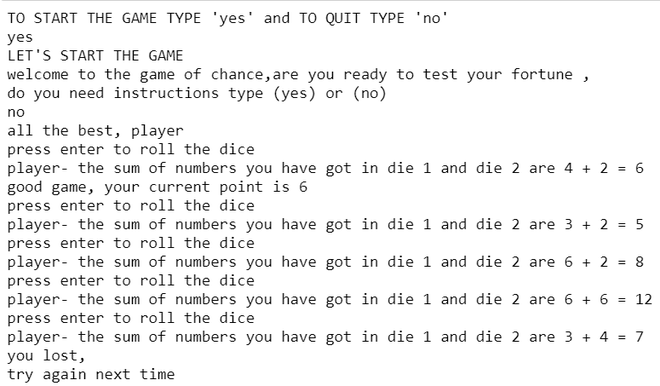Python中的掷骰子游戏
在本文中,我们将讨论如何使用Python创建掷骰子游戏。
游戏规则:
- 需要两个骰子才能玩,玩家掷两个六面骰子并将滚动在一起的数字相加。
- 如果玩家在第一次掷出的总点数为 7 或 11,则玩家自动获胜,如果玩家掷出的总点数为 2、3 或 12,则玩家自动失败,游戏结束。
- 如果玩家在第一次掷骰时总共掷出 4、5、6、8、9 或 10,则该数字成为“点”。然后玩家继续掷两个骰子,直到发生两件事之一,他们再次掷出“点”,在这种情况下他们赢了,或者他们掷出了 7,在这种情况下他们输了。
方法:
- 当您首先运行程序时,您可以选择是开始游戏还是退出游戏,这是通过在继续玩游戏后导入sys模块来完成的,您将获得查看游戏规则的选项游戏或者如果您已经熟悉规则,您可以选择不看它们。
- 当您按进入随机模块开始游戏时,随机选择 1 到 6 之间的两个数字。然后通过使用diceNumber()函数,将两个数字相加。
- 现在按照游戏规则,如果你的骰子总数是 7 或 11,你就赢了。如果您的总得分为 2、3、12,您将自动输掉。
- 如果您的总数是 4、5、6、8、9 或 10,则该总数将被保存,程序将循环运行,直到发生两件事 1)您的得分与以前相同或您的得分为 7。如果您有得分与之前相同的数字您将获胜,如果您的总得分为 f 7,则您输了。
执行:
Python3
# import required modules
import random
import sys
# stat the game
a = input("TO START THE GAME TYPE 'yes' and TO QUIT TYPE 'no'\n")
if a.lower() == "no":
sys.exit()
else:
print("LET'S START THE GAME")
# those who need instructions can ask for it,
# others can start the game directly.
a = input("welcome to the game of chance,are you ready to test your fortune ,\ndo you need instructions type (yes) or (no) \n")
if a.lower() == "yes":
print(''' 1. player rolls two six-sided dice and adds the numbers rolled together.
2. On this first roll, a 7 or an 11 automatically wins, and a 2, 3, or 12automatically loses, and play is over.
If a 4, 5, 6, 8, 9, or 10 are rolled on this first roll, that number becomes the 'point.'
3. The player continues to roll the two dice again until one of two things happens:
either they roll the 'point' again, in which case they win; or they roll a 7, in which case they lose.''')
elif a.lower() == "no":
print("all the best, player")
# function to generate dice throws
def diceNumber():
_ = input("press enter to roll the dice ")
# this will enable to select a
# random number from 1 to 6
die1 = random.randrange(1, 7)
die2 = random.randrange(1, 7)
# returns the diceNumber values
# in the form of tuple
return (die1, die2)
# function to get dice sum
def twoDice(dices):
die1, die2 = dices
print("player- the sum of numbers you have got in die 1 and die 2 are {} + {} = {}".format(die1, die2, sum(dices)))
# calling the diceNumber function to get a value
# return the roll and then store that
# value in value.
value = diceNumber()
twoDice(value)
# using the sum function in value to
# find the sum of two outcomes.
sum_of_dices = sum(value)
# find if sum of dices is 7 or 11 to determine the result.
if sum_of_dices in (7, 11):
result = "congratulations you won"
# find if sum of dices is 2 , 3 , 12 to determine the result.
elif sum_of_dices in (2, 3, 12):
result = "you lost, \ntry again next time"
# if none of the cases worked above now we will
# play continuously until we win or lose.
else:
result = "continue your game please"
currentpoint = sum_of_dices
print("good game, your current point is", currentpoint)
# game continues if you have not scored a
# total of 2 , 3 , 7 , 11 , 12 this will
# enable the game to continue in a loop until
# the outcome is win or lose
while result == "continue your game please":
value = diceNumber()
twoDice(value)
sum_of_dices = sum(value)
if sum_of_dices == currentpoint:
result = "congratulations you won"
elif sum_of_dices == 7:
result = "you lost,\n try again next time"
# when the outcome is clear,this will produce the
# outcome of the game
if result == "congratulations you won":
print("congratulations,you won")
else:
print("you lost, \ntry again next time")输出:
